In this article we can see about the benefits of top 5 Special nut. You can see the Benfits of common nuts if you were interested in knowing about Common Nuts.
1. Macadamia nuts

Macadamia nuts are a type of tree nut that are native to the east coast of Australia, specifically the rainforests of Queensland and New South Wales. The nuts are named after John Macadam, a Scottish-Australian chemist and politician who first identified the tree in the 19th century.
The macadamia tree was first cultivated commercially in Hawaii in the early 20th century, and the state remains one of the world’s leading producers of the nut. Macadamia nuts are also grown in other tropical regions around the world, including South Africa, Central and South America, and California.
Here are some interesting facts about macadamia nuts:
- The macadamia nut is one of the most expensive nuts in the world, due to its relatively low yield and high demand.
- The macadamia tree can take up to 7 years to start producing nuts, and can continue to produce nuts for up to 100 years.
- They are incredibly hard to crack open, due to their thick, woody shells. In fact, it takes a pressure of about 300 pounds per square inch to crack open a macadamia nut.
- They are incredibly high in fat, with about 75% of their calories coming from fat. However, the majority of this fat is monounsaturated, which is considered to be a “good” fat that can help to improve heart health.
- They are also a good source of fiber, protein, and various vitamins and minerals, including magnesium, manganese, and vitamin B6.
- They are often used in baking and confectionery, such as in cookies, cakes, and chocolate bars.
- It’s oil is also used in cooking, and is prized for its rich, buttery flavor and high smoke point.
1.1. Nutrients
- Protein
- Monounsaturated fat
- Vitamin E
- Manganese
- Thiamin
- Copper
1.2. Medical Benefits
- Lower Risk of Metabolic Syndrome.
- Lower Your Risk of Cardiovascular Disease.
- Reduced Risk of Diabetes.
- Support Your Digestive Health.
- Help with Weight Loss.
1.3. Side Effects (if overconsumed)
- Nut Allergy.
- Selenium toxicity.
2. Brazil nuts
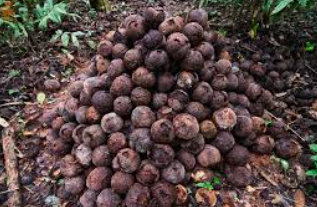
Brazil nuts are a type of nut that comes from the Brazil nut tree, which is native to the Amazon rainforest in South America. The tree is one of the tallest in the rainforest, reaching up to 160 feet in height, and it can live for up to 1,000 years.

Here are some interesting facts about Brazil nuts:
- The Brazil nut is not actually a nut, but rather a seed from the Brazil nut tree. The outer shell of the seed is extremely hard, and it can take up to a year for the seed to mature and fall from the tree.
- Brazil nuts are high in healthy fats, protein, and minerals such as selenium, magnesium, and zinc. Selenium is especially important for thyroid health and immune system function.
- Brazil nuts are an important food source for many animals in the Amazon rainforest, including monkeys, birds, and rodents.
- The harvesting of Brazil nuts is a labor-intensive process. The outer shell of the seed is so hard that it requires a machete or heavy-duty tool to crack it open, and the seeds must be carefully removed to avoid damaging them.
- Brazil nuts have a rich, buttery flavor and are often used in baking and confectionery, such as in cookies, cakes, and chocolate bars.
- Brazil nuts are often sold in their shells, which are extremely hard and difficult to crack open. They are also sold shelled, either whole or chopped.
- In addition to their culinary uses, Brazil nuts are also used in traditional medicine in South America to treat a variety of ailments, including respiratory problems and skin conditions.
2.1. Nutrients
- Vitamin B1
- Vitamin B6
- Vitamin E
- Calcium
- Copper
- Magnesium
- Manganese
- Phosphorous
- Zinc
2.2. Medical Benefits
- Thyroid health
- Reduced Risk of Heart Disease
- Diabetes Management
- Inflammation Relief
- Bone Health
- Brain Health
2.3. Side Effects (if overconsumed)
Less is more in case of Brazil nuts, So always be careful with your intake with Brazil Nuts.
- Gastrointestinal problems
- Dizziness
- Brittle hair and nails
- Joint pain
- Irritability
- Tiredness
- Kidney failure
- Heart attack
- Heart failure
3. Hazelnuts
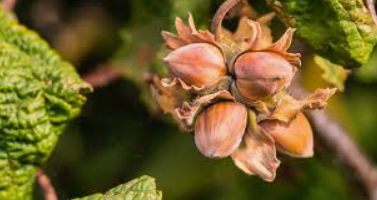
Hazelnuts, also known as filberts, are a type of nut that comes from the hazelnut tree. The tree is native to Europe and Asia, but is now grown in many parts of the world, including the United States, Turkey, and Italy. Here are some interesting facts about hazelnuts:
- Hazelnuts are a rich source of protein, healthy fats, and fiber, as well as vitamins and minerals such as vitamin E, copper, and manganese.
- Hazelnuts have been a popular food source for thousands of years. They were cultivated by ancient Greeks and Romans and were considered a symbol of fertility and abundance.
- Hazelnuts are used in a variety of culinary applications, including in confectionery, baked goods, and as a topping for salads and oatmeal.
- One of the most famous uses of hazelnuts is in Nutella, a popular chocolate-hazelnut spread that originated in Italy in the 1940s.
- Hazelnuts are also used in the production of pralines, a type of candy made by caramelizing sugar and mixing it with nuts.
- The harvesting of hazelnuts requires a great deal of care, as the nuts can be easily damaged during the harvesting and processing process.
- Hazelnuts are also used in traditional medicine, particularly in Europe, where they have been used to treat ailments such as coughs, colds, and digestive problems.
3.1. Nutrients
- Vitamin E
- Thiamin
- Magnesium
- Copper
- Manganese
- Vitamin B6
- Folate
- Phosphorus
- Potassium
- Zinc
3.2. Medical Benefits
- Aids in Digestion.
- Improves Heart Health.
- Reduces the Risk of Cancer.
- Helps Regulate Blood Sugar Levels.
- Reduces Inflammation in the Body.
- Strengthening Bones.
- Boosts Immunity.
- Increases Micronutrients in the Body.
- Improves Fertility.
- Hazelnut Benefits Hair.
3.3. Side Effects (if overconsumed)
While hazelnuts are considered safe for most people, they’re not recommended for those with an allergy to tree nuts such as pecans and walnuts (also some people who are allergic to peanuts may also be allergic to hazelnuts).
4. Chestnuts
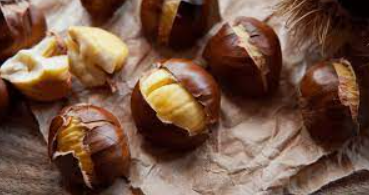
Chestnuts are a type of nut that come from the chestnut tree, which is native to the temperate regions of the Northern Hemisphere. Here are some interesting facts about chestnuts:
- Chestnuts have been an important food source for humans for thousands of years. Archaeologists have found evidence of chestnut consumption dating back to the Paleolithic era.
- Chestnuts were a staple food in many cultures throughout history, including in ancient Rome and China.
- Chestnuts were also used in traditional medicine. In China, chestnuts were used to treat respiratory problems and improve digestion.
- Chestnuts have a distinct flavor and texture that sets them apart from other nuts. They are lower in fat than many other nuts and are a good source of dietary fiber.
- Chestnuts are used in a variety of culinary applications, including in soups, stews, and stuffing. They are also a popular ingredient in desserts, such as chestnut cakes and pastries.
- Chestnuts are commonly roasted, which brings out their natural sweetness and gives them a delicious nutty flavor.
- In many cultures, chestnuts are associated with the fall season and are used in holiday dishes such as Thanksgiving stuffing.
- The chestnut tree is a long-lived tree that can live for up to 1,000 years. It is also an important timber tree, as its wood is highly prized for its durability and resistance to decay.
- Chestnuts are rich in vitamins and minerals, including vitamin C, potassium, and magnesium.
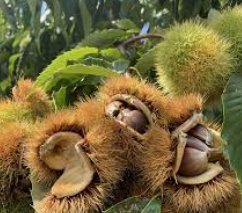
4.1. Nutrients
- Vitamin C
- Vitamin
- Thiamin
- Riboflavin
- Niacin
- Vitamin B6
- Folate
- Pantothenic Acid
- Calcium
- Potassium
- Phosphorus
- Iron
- Manganese
4.2. Medical Benefits
- Good source of antioxidants.
- May support the heart.
- High in fibre.
- May improve blood sugar management.
- May help weight management.
4.3. Side Effects (if overconsumed)
Chestnut is safe for most people is except of the people who has nut allergies.It doesn’t mean that we can overconsume.
5. Pine nuts
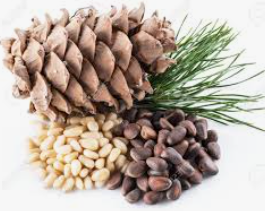
Pine nuts are the edible seeds of pine trees and have been an important food source for many cultures throughout history. Here are some interesting facts about pine nuts:
- It is one of the oldest foods known to humanity and have been used as a food source for thousands of years. They were a staple food of many indigenous cultures, including the Native Americans of the Southwest United States.
- It is harvested from several different species of pine trees, including the stone pine, Korean pine, and Siberian pine.
- It is high in fat and protein, making them a valuable source of nutrition. They are also a good source of vitamins and minerals, including vitamin E, magnesium, and zinc.
- It have a sweet, nutty flavor and are often used in Mediterranean and Middle Eastern cuisine. They are a popular ingredient in dishes such as pesto sauce, salads, and baked goods.
- It is also used in traditional medicine. In China, pine nuts are believed to improve kidney function and boost energy levels.
- The harvesting of pine nuts can be a labor-intensive process. The cones from the pine trees are typically collected by hand and then dried to release the seeds.
- In recent years, the demand for pine nuts has increased, leading to concerns about over-harvesting and unsustainable practices. Some companies have begun to offer sustainably harvested pine nuts to address these concerns.
- It is often expensive due to the labor-intensive harvesting process and the high demand for them.
- It can also have a side effect known as “pine mouth,” which is a bitter, metallic taste that can last for several days. This is caused by a chemical compound found in some pine nuts, and it is not harmful to health.
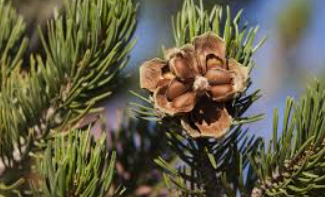
5.1. Nutrients
- Carbohydrates
- Fiber
- Sugars
- Protein
- Magnesium
- Zinc
- Iron
- Manganese
- Vitamin E
- Vitamin K
5.2. Medical Benefits
- Improves Glycemic Control.
- Supports Heart Health.
- Aids Cognition.
- May Help Prevent Colon Cancer.
- Aids Healthy Weight Management.
- Reduces Inflammation.
5.3. Side Effects (if overconsumed)
- Pine mouth syndrome
- Allergies
- Anaphylaxis
- Urticaria (red bumps or rashes on the skin)
- Angioedema (swelling of face, nose, throat, etc.)
2 responses to “Benefits of 5 Top Special Nuts”
-
Can you be more specific about the content of your article? After reading it, I still have some doubts. Hope you can help me.
-
Can you be more specific about the content of your article? After reading it, I still have some doubts. Hope you can help me.




Leave a Reply